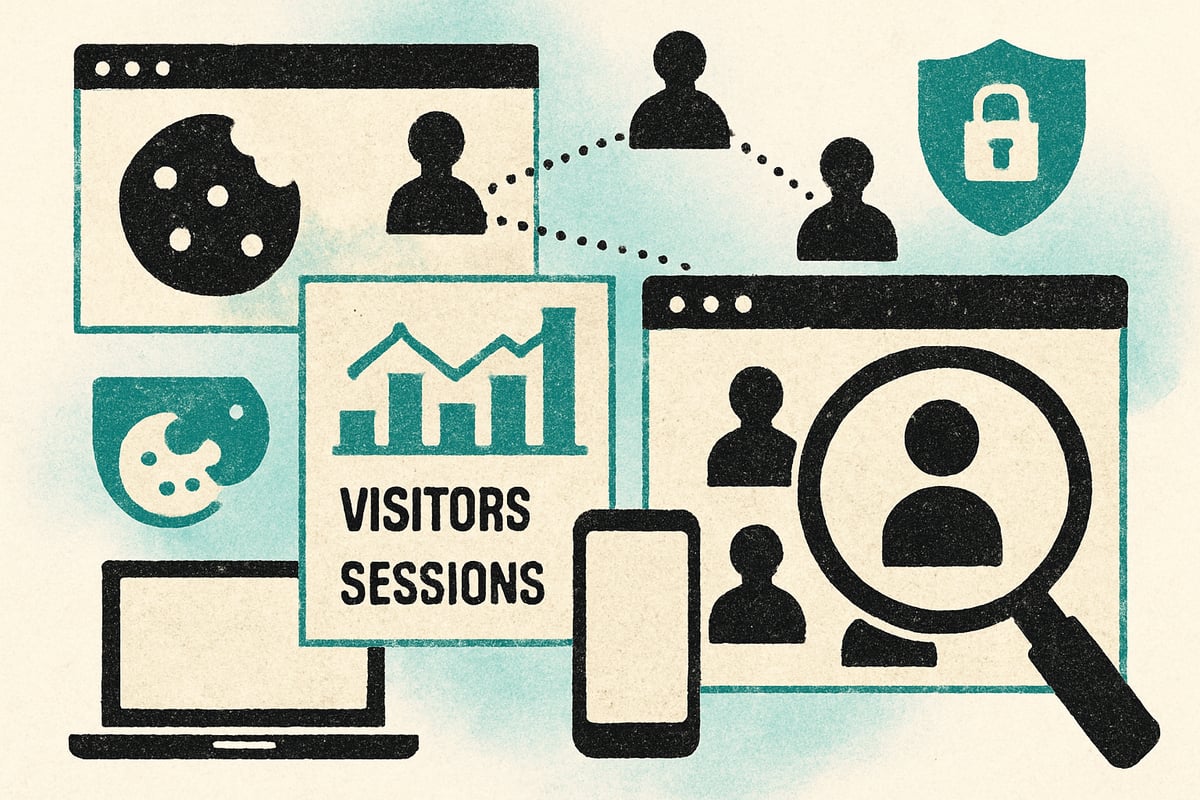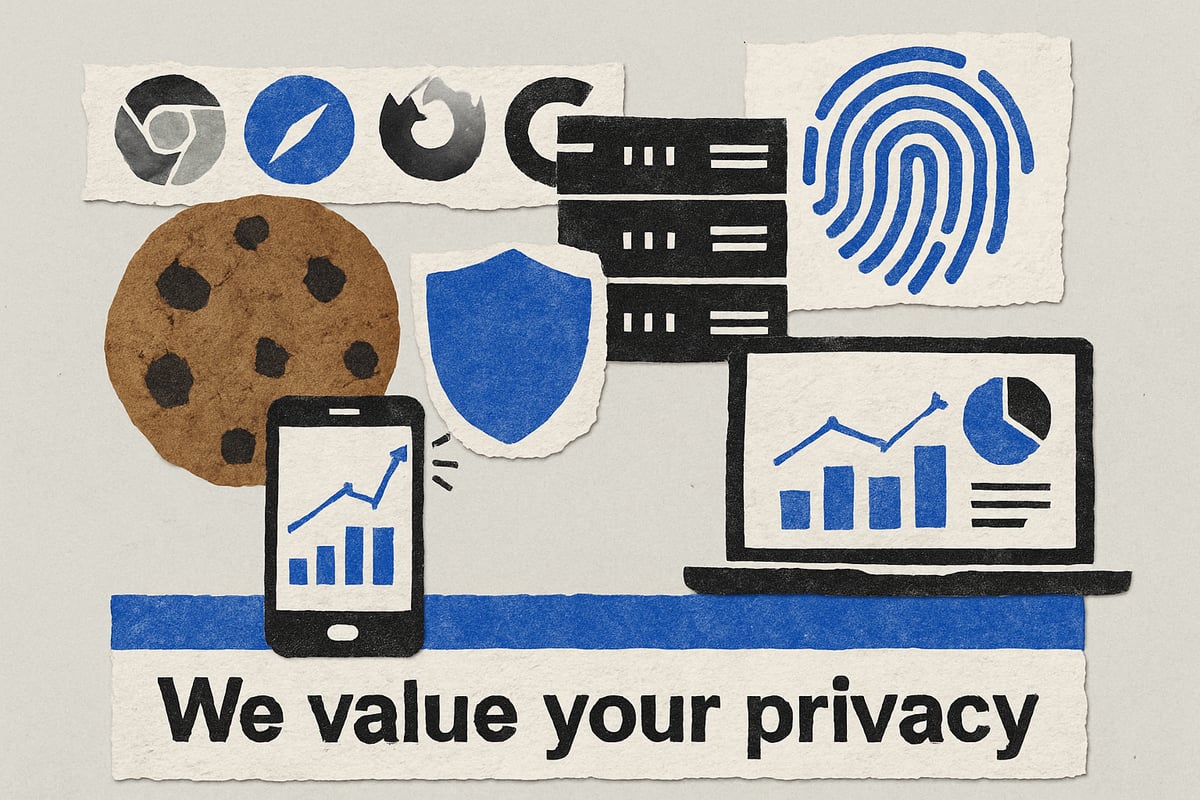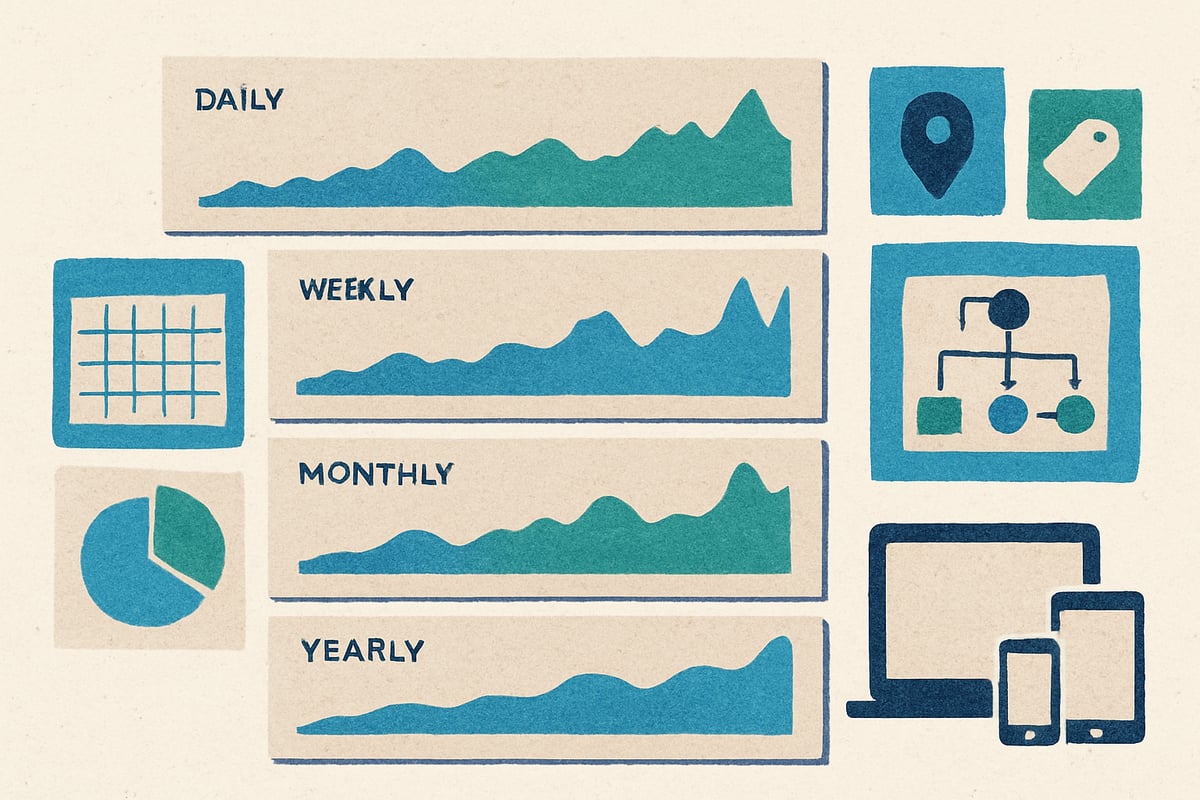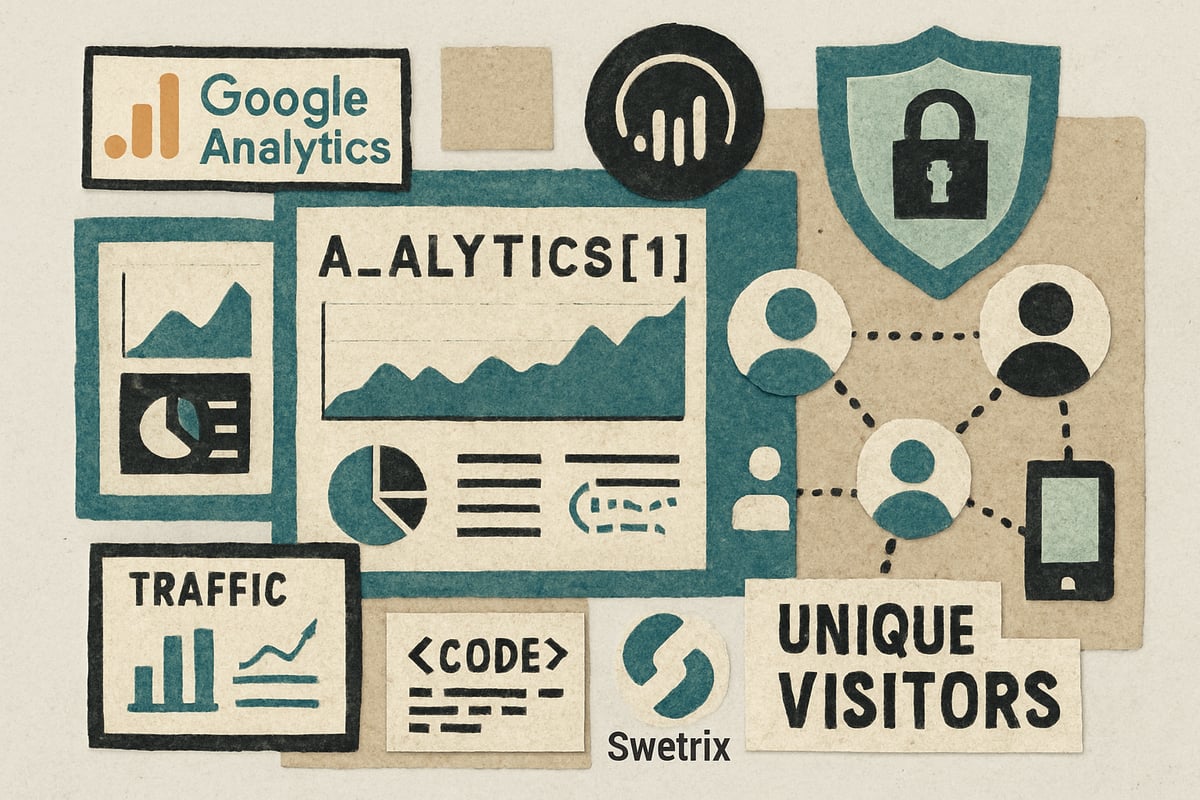- Date
Unique Visitors: What They Are and Why They Matter
 Andrii Romasiun
Andrii Romasiun
In 2025, understanding unique visitors is essential for anyone aiming to achieve digital growth. As website analytics rapidly evolve, keeping pace with new technologies and privacy trends is no longer optional.
This comprehensive guide will clarify what unique visitors truly represent, how this metric is measured, and why it is at the core of effective online strategy. You will learn to interpret your audience data accurately and use it to inform decisions that drive real business results.
Are you ready to master website traffic analysis for the future? Let’s dive in and unlock the full potential of your site’s data.
What Are Unique Visitors? Defining the Core Metric
Understanding unique visitors is fundamental for anyone analyzing website traffic. This metric counts each individual only once within a defined period, no matter how often they visit. Unlike sessions or pageviews, which can tally multiple interactions by the same person, unique visitors offer a clearer sense of your true audience size.

The Meaning of Unique Visitors
Unique visitors represent the number of distinct individuals who access a website within a set timeframe, such as a day or month. This means if a user returns multiple times, they are only counted once for that period. In contrast, metrics like sessions or pageviews capture each visit or page load, often inflating perceived audience size.
For example, if a person visits your site daily for a week, analytics will still count them as one unique visitor during that week. This approach helps businesses understand the actual reach of their digital presence.
It is important to note that unique visitors do not always equal unique people. Device or browser differences, as well as privacy tools, can cause one person to appear as multiple unique visitors. Most analytics tools rely on cookies or identification methods to track this metric. Ultimately, unique visitors are critical for digital marketing, business reporting, and audience analysis.
Unique Visitors vs. Sessions and Pageviews
To fully grasp unique visitors, it helps to compare them with sessions and pageviews. A session refers to a single visit to your website, potentially including multiple pageviews. Pageviews count each time a page loads, regardless of who is viewing it. One person can generate several sessions and many pageviews.
Consider this example:
| Metric | Counted By | Example (1 user, 5 visits, 20 pages) |
|---|---|---|
| Unique Visitors | Individual user | 1 |
| Sessions | Each visit | 5 |
| Pageviews | Each page load | 20 |
Unique visitors provide a more accurate measure of your site's true reach than sessions or pageviews, which can be inflated by repeat activity. For advertisers and content strategists, this distinction is crucial for campaign analysis. For a deeper dive into these differences, see Page visitors vs. sessions.
Why Unique Visitors Matter in 2025
In 2025, unique visitors are more important than ever due to the shift toward privacy-first analytics. As data collection becomes more regulated, unique visitors offer a privacy-conscious way to assess site popularity and audience growth. This metric is essential for advertisers, content creators, and e-commerce leaders who need to gauge and compare audience expansion year over year.
For example, tracking unique visitor growth from one quarter to the next reveals whether your marketing strategies are attracting new people. As analytics platforms improve cross-device and cross-platform tracking, understanding unique visitors becomes vital for measuring real user reach in an increasingly fragmented digital world.
Common Pitfalls and Misunderstandings
Despite their value, unique visitors are often misunderstood. Many assume this metric equals the actual number of people visiting a site, but technical limitations can lead to inaccuracies. If one person accesses your site from both a desktop and a mobile device, analytics may count them as two unique visitors.
Clearing cookies, using incognito modes, or switching browsers can also reset identifiers, causing double-counting. Privacy tools further complicate tracking by limiting the data available. To combat these challenges, analytics platforms use advanced deduplication techniques and encourage login-based identification when possible. Still, when interpreting unique visitors, always consider these variables to avoid misinformed decisions.
How Unique Visitors Are Tracked in 2025
Tracking unique visitors in 2025 requires a blend of new and traditional technologies. As analytics evolves, businesses must adapt their strategies to ensure accuracy and privacy compliance. Understanding how these systems identify and count unique visitors is crucial for anyone seeking actionable website insights.

Tracking Technologies and Methods
Modern analytics platforms use a combination of tracking techniques to identify unique visitors. These include browser cookies, device fingerprinting, local storage, and server logs. Each method has strengths and weaknesses, especially as privacy standards rise.
| Tracking Method | How it Works | Pros | Cons |
|---|---|---|---|
| Cookies | Stores visitor ID in browser | Widely used | Blocked by some browsers |
| Device Fingerprinting | Reads browser/device properties | Harder to block | Privacy concerns |
| Local Storage | Saves data in browser storage | Persistent | Cleared with cache |
| Server Logs | Logs IP and user agent | No client storage | Less accurate, privacy risk |
Platforms like Adobe Analytics combine several ID methods, such as visitorID, aid, mid, fid, and IP/User Agent, to improve identification accuracy. The goal is to count each unique visitor just once per reporting period, even as users interact in complex ways.
As privacy regulations evolve, tracking methods continue to adapt, balancing the need for accurate measurement with user data protection.
The Role of Cookies and Cookieless Tracking
For many years, cookies were the cornerstone of unique visitors tracking. They stored small identifiers in a user's browser, allowing analytics tools to recognize repeat visits within set timeframes.
However, cookie consent requirements and browser restrictions have made this approach less reliable. Users now routinely block or delete cookies, causing gaps in tracking. To address this, new solutions have emerged that do not rely on cookies at all.
Cookieless analytics platforms use methods like anonymous device signals or session-based tracking, ensuring compliance with regulations like GDPR. For a deeper look at how cookies influence visitor tracking and the shift toward cookieless solutions, see Everything about cookies in analytics.
This transition enables organizations to measure unique visitors accurately while prioritizing user privacy.
Cross-Device and Cross-Browser Challenges
In 2025, identifying unique visitors across multiple devices and browsers remains a significant challenge. A single person may use a phone, tablet, and desktop, each potentially counted as a separate visitor.
Analytics platforms have introduced cross-device tracking, unified IDs, and login-based analytics to address this. When a user logs into an account on different devices, platforms can deduplicate their visits, offering a more accurate picture.
Still, when users do not authenticate, the same individual may be counted as several unique visitors. Some platforms report on "unique devices" or "people" instead, reflecting the limitations of current technology.
Cross-device analytics is essential for businesses seeking to understand the true reach and behavior of their audience.
Privacy Regulations and Their Impact
Global privacy laws, such as GDPR and CCPA, have a profound effect on how unique visitors are tracked. These regulations require explicit user consent before any tracking can occur, and strict guidelines govern data retention and usage.
Analytics tools have adapted by offering configurable consent banners, anonymization features, and data deletion protocols. For example, platforms may automatically delete visitor profiles after 13 months of inactivity to align with regulatory requirements.
These changes mean that some visitor data may be incomplete, especially if users decline tracking. As a result, organizations must interpret unique visitors metrics with privacy-induced gaps in mind, prioritizing ethical data practices.
Behaviors That Affect Unique Visitor Counts
Certain user actions can unintentionally inflate unique visitors counts. Clearing cookies or cache, browsing in incognito mode, or switching between browsers and devices all result in new identifiers being assigned.
For example, if one user accesses a site via Chrome on a laptop and Safari on a phone, they are counted as two unique visitors. Similarly, clearing browser data resets identifiers, making repeat visits appear as new ones.
To mitigate these effects, analytics platforms employ deduplication strategies and recommend best practices:
- Encourage user logins for tracking across sessions
- Regularly audit and clean analytics data
- Understand the limitations of browser-based identification
Interpreting unique visitors data in 2025 means recognizing these behaviors and adjusting analysis accordingly.
Key Metrics: Granularity and Timeframes
Understanding how unique visitors are measured across different timeframes and dimensions is essential for accurate website analysis. Metrics like daily, weekly, or monthly unique visitors can reveal distinct trends and support smarter business decisions. In 2025, knowing how to interpret these numbers is key to optimizing your site and campaigns.

Daily, Weekly, Monthly, and Yearly Unique Visitors
Unique visitors can be reported over various timeframes, each offering specific insights. For example, daily unique visitors highlight short-term spikes, while monthly unique visitors capture broader audience reach. The difference comes from deduplication: a user visiting multiple days in a month is counted once for monthly unique visitors but each day for the daily metric.
Consider this scenario: If a user visits your website every day for a week, analytics will count seven daily unique visitors but only one weekly unique visitor. This distinction is crucial for trend analysis, campaign measurement, and understanding user loyalty.
Industry benchmarks frequently use monthly unique visitors to compare performance.
Granularity in Reporting and Deduplication
Analytics platforms use sophisticated methods to deduplicate unique visitors across custom date ranges. When you generate a report for a specific timeframe, the system aggregates visitor data and ensures each individual is counted only once, based on their identifier.
For example, if a user visits on three separate days within a week, deduplication ensures only one unique visitor is reported for that entire week. This process prevents overestimating audience size, especially in executive dashboards or campaign summaries.
Custom granularity lets you align reporting with business needs, whether you are tracking a short-term promotion or analyzing annual growth. Always verify how your analytics tool handles deduplication to maintain data accuracy.
Segmenting Unique Visitors by Dimension
Segmenting unique visitors by dimensions such as source, device, location, or campaign provides actionable insights. By analyzing unique visitors from different channels, you can identify which acquisition strategies yield the highest value.
For instance, you might compare unique visitors by country to evaluate international reach or segment by marketing channel to optimize ad spend. Device segmentation reveals whether users prefer mobile or desktop, guiding UX improvements.
Lists and tables can help visualize these segments, making it easier to spot trends and opportunities. Ultimately, segmentation empowers marketers to target high-potential audiences and personalize experiences.
Advanced Metrics: People, Devices, and Customer Journeys
As analytics evolve, advanced metrics go beyond traditional unique visitors. Platforms now offer metrics like unique devices and "people," which use cross-device deduplication and unified IDs to track individuals across multiple touchpoints.
This approach is essential for mapping the complete customer journey. For example, unified IDs allow you to see how a user interacts with your brand on both mobile and desktop before converting. These insights drive more effective personalization and support seamless omnichannel experiences.
Understanding the relationship between unique visitors, devices, and journeys will be increasingly important for businesses aiming to optimize every stage of the user lifecycle.
Analytics Tools and Evolving Solutions for Unique Visitor Tracking
As digital analytics rapidly evolve, tracking unique visitors remains central to understanding website performance. In 2025, the landscape of analytics tools is more diverse than ever, with established giants and innovative privacy-first alternatives offering a range of solutions. Selecting the right platform requires a keen understanding of both technical features and compliance requirements.

Leading Analytics Platforms in 2025
In 2025, several analytics platforms stand out for their ability to track unique visitors effectively. Google Analytics 4 and Adobe Analytics continue to lead, offering robust data collection, flexible reporting, and enhanced privacy controls. Both platforms have adapted to regulatory shifts by introducing new methods for deduplicating unique visitors across devices.
Privacy-focused alternatives are gaining traction. These tools emphasize minimal data collection while still delivering actionable insights. For comparison, Adobe Analytics uses a hierarchy of visitor IDs to ensure more accurate unique visitor counts even when cookies are restricted. The table below summarizes key features:
| Platform | Unique Visitor Tracking | Privacy Compliance | Cross-Device |
|---|---|---|---|
| Google Analytics 4 | Yes | High | Moderate |
| Adobe Analytics | Yes (multiple IDs) | High | Advanced |
| Privacy-First Tools | Yes (cookieless) | Very High | Varies |
As organizations prioritize both accuracy and privacy, choosing a platform with strong unique visitors tracking is essential.
Privacy-First and Cookieless Analytics Solutions
Privacy-first analytics solutions have surged in popularity due to stricter regulations and growing user expectations. These platforms avoid personal identifiers and often use cookieless tracking to count unique visitors, ensuring GDPR and CCPA compliance. Many businesses find these tools attractive because they eliminate the need for intrusive cookie banners and minimize legal risks.
Key privacy features include anonymized data collection, real-time reporting, and transparent user consent mechanisms. To better understand the intersection of privacy and actionable insights, explore this resource on web analytics privacy and insights.
With privacy at the forefront, organizations can confidently analyze unique visitors while respecting user rights.
Swetrix: Privacy-First Unique Visitor Analytics
Swetrix stands out as a modern, open-source analytics platform designed for privacy-first tracking of unique visitors. Unlike traditional tools, Swetrix operates entirely without cookies or personal data, making it fully GDPR-compliant. Its cookieless tracking approach ensures that visitor counts remain accurate, even as browsers tighten restrictions.
Swetrix offers real-time traffic insights, error monitoring, and customizable alerts, all within a user-friendly dashboard. For organizations seeking full control, self-hosting is available, allowing complete data ownership. By focusing on actionable analytics and privacy, Swetrix empowers businesses to make meaningful decisions based on unique visitors without compromising user trust.
Choosing the Right Tool for Your Needs
Selecting the ideal analytics platform for tracking unique visitors involves several critical considerations. Privacy requirements should be at the top of your list, especially in regulated industries. Assess the technical complexity of each tool and ensure it integrates smoothly with your existing stack.
Reporting flexibility is also vital. Some platforms offer highly customizable dashboards, while others prioritize simplicity. Transparent and ethical analytics practices are becoming the standard in 2025. When evaluating options, choose a solution that balances actionable insights with strict regulatory compliance, ensuring your unique visitors data is both reliable and responsible.
Making the Most of Unique Visitor Data: Strategies and Best Practices
Unlocking the full potential of unique visitors data requires more than just tracking numbers. To drive growth and optimize your website in 2025, you need actionable strategies, a clear understanding of limitations, and a focus on meaningful insights. Let’s explore how you can interpret, combine, and leverage unique visitors data for real results.
Interpreting Unique Visitor Trends
Analyzing unique visitors over time reveals the true health of your website. Look for consistent growth, seasonal fluctuations, or sudden changes in traffic patterns. A spike in unique visitors may indicate a successful campaign, while a dip could signal technical issues or loss of interest.
Regularly reviewing these trends helps you spot opportunities and threats. Always consider the context, such as product launches, marketing pushes, or external factors like search engine updates. By understanding the story behind your unique visitors data, you can make timely, informed decisions that keep your digital strategy on track.
Combining Unique Visitor Data with Other Metrics
Unique visitors are most powerful when combined with other analytics. Pair this metric with sessions, pageviews, and conversions to gauge engagement and site performance. For example, if unique visitors are rising but average session duration is falling, your content may not meet visitor expectations.
Key combinations to monitor include:
- Unique visitors vs. conversion rate
- Unique visitors per channel or campaign
- Average sessions per unique visitor
This holistic view enables you to pinpoint strengths and weaknesses, ensuring your site drives both reach and results.
Segmenting and Targeting Based on Unique Visitor Insights
Segmenting unique visitors lets you uncover valuable audience patterns. Break down visitors by source, device, location, or campaign to identify high-performing segments. For instance, you may find that mobile users from specific regions convert at a higher rate.
Actionable segmentation strategies include:
- Targeting return unique visitors with personalized offers
- Customizing content for top-performing traffic sources
- Running campaigns tailored to new unique visitors
These insights empower you to deliver relevant experiences, boost engagement, and maximize your marketing ROI.
Addressing Data Quality and Limitations
No analytics system is perfect. Unique visitors counts can be inflated by bots, double-counted due to device switching, or underreported thanks to privacy tools. To improve data quality, regularly filter out known bots and use advanced deduplication methods.
Understand how privacy regulations impact your reporting. For more on foundational analytics challenges, see What is web analytics. Always communicate possible limitations to stakeholders, so decisions are based on realistic expectations and not just raw numbers.
Leveraging Unique Visitor Data for Business Growth
Unique visitors data is a cornerstone for business growth strategies. Use this metric to set clear KPIs, measure the impact of campaigns, and track audience expansion. When unique visitors climb steadily, it often signals effective outreach and growing brand awareness.
Integrate unique visitors insights into marketing, product development, and customer experience planning. Align team goals with traffic objectives, and use these benchmarks to justify investments or pivot strategies as needed. Consistently tracking progress ensures your business stays agile and competitive.
Real-World Examples and Case Studies
Consider an e-commerce site that uses unique visitors to refine its conversion funnel, identifying where drop-offs occur and optimizing accordingly. Publishers regularly analyze unique visitors growth to attract advertisers and justify premium ad rates.
Industry benchmarks also offer valuable context. For the latest data on website traffic and how unique visitors stack up across sectors, explore the Benchmarking Website Traffic: Guide + 2025 Data. Learning from real-world examples and benchmarks helps you set realistic goals and measure success against industry standards.
The Future of Unique Visitor Analytics: Trends and Predictions for 2025
The landscape of unique visitors analytics is rapidly evolving. As we look ahead to 2025, organizations face new challenges and opportunities in how they measure, interpret, and act on this critical metric. Let’s explore the key trends shaping the future of unique visitors and what they mean for your digital strategy.
The Shift Toward Privacy and Ethical Analytics
Privacy is at the forefront of unique visitors analytics in 2025. With regulations tightening worldwide, businesses are prioritizing ethical data collection and transparency. Users now expect control over their data, prompting analytics platforms to offer privacy-first solutions. According to HubSpot's 2025 Web Trends Report, the demand for privacy-centric analytics is reshaping how unique visitors are tracked and reported. As a result, companies must balance actionable insights with compliance, ensuring they only collect what is necessary for meaningful analysis.
Advances in Cross-Device and Identity Resolution
Tracking unique visitors accurately across multiple devices remains a challenge. In 2025, new technologies are bridging this gap. Platforms are leveraging unified customer IDs, login-based analytics, and AI-driven matching to deduplicate users. This shift allows businesses to follow the customer journey more precisely, even as visitors move between smartphones, tablets, and desktops. As cross-device analytics matures, the focus is shifting from counting devices to understanding people, offering a clearer picture of unique visitors and their behaviors.
The Role of AI and Automation in Traffic Analysis
Artificial intelligence is transforming unique visitors analytics. AI-powered tools can detect anomalies, predict trends, and automate reporting with remarkable speed. For example, automated alerts now notify teams of significant changes in unique visitors, allowing prompt responses to traffic spikes or drops. Machine learning also helps identify patterns in user engagement, supporting more effective segmentation and personalization. As automation becomes standard, businesses can focus on strategy rather than manual data analysis.
Navigating Data Loss and Incomplete Tracking
Privacy regulations and browser restrictions have introduced new obstacles for tracking unique visitors. Many users block cookies or use privacy tools, leading to gaps in data. Organizations are responding by emphasizing first-party data and obtaining explicit consent. Server-side tracking is also gaining traction, helping to mitigate data loss. Still, it is essential to recognize the limitations of unique visitors metrics and interpret trends with caution, particularly when data is incomplete or fragmented.
Integrating Unique Visitor Data into Omnichannel Strategies
In 2025, unique visitors data is no longer siloed. Businesses are integrating web analytics with data from mobile apps, email campaigns, and offline interactions. This omnichannel approach creates a holistic view of the customer journey, enabling more accurate attribution and better decision-making. For instance, combining unique visitors counts from various channels helps identify touchpoints that drive engagement and conversions. The Digital 2025 July Global Statshot Report highlights the growing importance of unified analytics for global brands seeking comprehensive insights.
Preparing for the Next Evolution in Analytics
Looking ahead, the future of unique visitors analytics will be shaped by ongoing innovation and rising user expectations. Businesses should invest in privacy-first platforms, stay informed about regulatory changes, and continuously evaluate their analytics tools. Embracing transparency and user-centric approaches will ensure continued success. As analytics technology evolves, those who adapt quickly will gain a competitive edge by turning unique visitors data into actionable business growth.
As we've explored, understanding unique visitors is key to making smarter decisions and staying ahead in the evolving world of web analytics. If you value privacy, crave actionable insights, and want full control over your website data, you don't have to compromise. With Swetrix, you get a privacy-first platform that's open source, GDPR-compliant, and completely cookieless—so you never need to worry about intrusive banners or losing sight of your real audience. Ready to analyze your traffic with confidence and respect your users' privacy? Check out Swetrix today and see the difference for yourself.